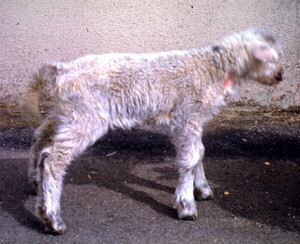Border Disease
History of the Disease
Border disease (BD, Fuzzy Lamb Syndrome or Hairy Shaker Disease) is a congenital disease of sheep that was first reported in the bordering countries of England and Wales. A similar, but rare condition also occurs in goats. A pestivirus causes BD, and is closely related to bovine viral diarrhea virus (BVDV) and swine fever virus (hog cholera). Although not as common as BVDV in cattle, BD virus is found worldwide in sheep. Five to fifty percent of sheep tested have antibodies against BD virus; meaning that these ewes have either been exposed to, or are carrying the disease. Transmission of the virus occurs via oral and/or intranasal routes in sheep, and can be spread from BVDV positive cattle to sheep. Persistently infected sheep are the primary virus reservoir. These ewes will shed virus in all excretions and secretions. Lambs of persistently infected ewes are at risk of becoming persistently infected with the BD virus, and hereby perpetuating the disease cycle.
Clinical signs: What to look for in your flock

- A. Intrauterine infection of ewes-
- Embryonic death with resorption
- Mummification
- Abortion
- Stillbirth
- B. Infected lambs:
- Death within first few days of life
- Increased bacterial and parasite problems.
- Affected lambs are more prone to parasite and bacterial infections
- Severe diarrhea and emaciation at weaning
- Nervous signs ( light tremors to apparent seizure-like activity). Nervous signs will decrease by three months of age
- Straight, hairy fleece at birth ( fleece abnormalities cannot be detected after three months of age)
- Abnormally pigmented coat. Coat may appear dark gray or have hyperpigmented spots over the top of the neck.
- Abnormally short or long legs, slender body structure
- Increased time to reach sexual maturity in persistently infected lambs
- Long, halo hairs in fleece
- C. Infected rams:
- Persistently infected rams may have poor quality semen (that contains the pestivirus)
- Acute infection is typically subclinical; viremia is transient and difficult to detect
- D. Infected goats:
- Fetal mummification and abortion
- Hypomyelination of spinal cord
- Normal hair coat
Diagnosis: How can you be sure that your sheep have BD?
- Clinical signs
- Virology tests (detects virus in nasal secretions an immune cells)
- Serologic test (ELISA test to look for antibody)
- PCR (commonly used to screen cattle for BVDV, although not routinely used in sheep)
- Necropsy findings
- Consult your veterinarian about these tests
Differential Diagnosis: What other diseases can cause similar symptoms?
- Swayback, bacterial meningoencephalitis, focal symmetrical encephalomalacia, muscular dystrophy, reproductive failures due to chlamydia or toxoplasma
Prevention: How to keep BD out of your flock
- Vaccines against the BD virus are not available. Ask your veterinarian about the use of BVDV vaccines.
- Serology test for BD virus of all replacement breeding stock
- Ensure that pregnant ewes test negative for antibodies
- If BD virus is endemic to an area, keep flocks on separate pastures
- Eliminate affected lambs from the flock
- Keep breeding ewes separate from cattle
Therapy: How can affected animals be treated?
- No treatment is available.
Economic Impact: How does this affect the rancher?
- Low birth weights
- Reduction of weaning weights
- Lowered carcass quality
- Infertility
Prepared by Cleon V. Kimberling, Gerilyn A. Parsons, Jay Parsons, Anita Dennison, Terry Teraska, and Laurie Martinson
Optimal Livestock Services, LLC
970-231-2477
Copyright © 2013 CleonsCorner.com All Rights Reserved
